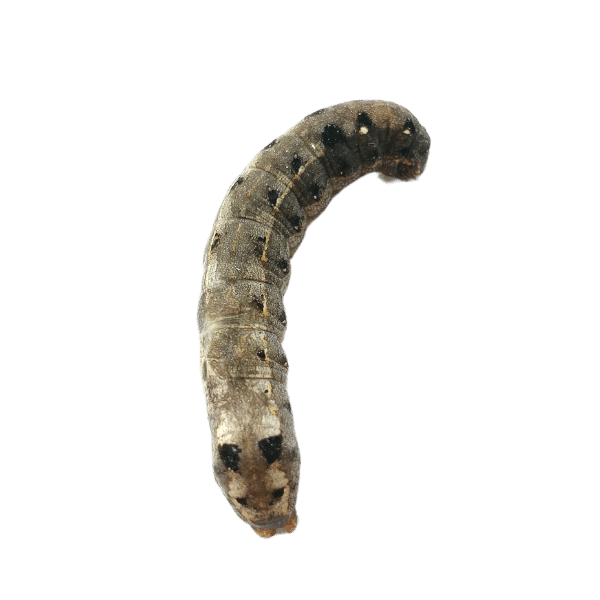Intro to the Insect:
Armyworms are destructive pests known for their ability to decimate lawns, crops, and gardens in North Alabama. These pests, which are the larval stage of moths, get their name from their tendency to march in large groups across lawns, consuming nearly everything in their path. The warm, humid summers of North Alabama provide ideal conditions for their development, particularly in late summer and early fall when their activity peaks. Armyworms prefer lush, well-irrigated grass such as Bermuda and fescue but can also attack ornamental plants and crops, making them a widespread problem for homeowners, farmers, and gardeners.
Which Ones Are Common in My Area and How Can I Identify Them?
The most common species in North Alabama is the fall armyworm (Spodoptera frugiperda). These caterpillars are easily identified by their unique characteristics:
- Body Color: Green, brown, or nearly black, with light stripes running along their body.
- Head Marking: An inverted white “Y” on their head.
- Rear Spots: Four dark circular spots arranged in a square pattern near their tail end.
Adult moths, tan to gray in color, are less noticeable but lay egg clusters on grass blades, siding, or tree bark, signaling an impending infestation. Early identification of egg masses or caterpillars can prevent widespread damage.
How Did I Get the Insect?
Armyworms are often introduced to lawns from nearby agricultural fields or wild areas, especially following heavy rainfall or harvests. They are drawn to:
- Well-maintained and fertilized lawns that provide ample food.
- Untreated areas where larvae can migrate into residential spaces.
- Grass blades, which serve as egg-laying sites for moths.
Understanding their source can help limit infestations and target effective prevention strategies.
What Effects Does This Have on My Lawn or Outdoor Space?
Armyworms are voracious feeders that can leave lawns and gardens looking barren. Their feeding habits cause:
- Grass blades to be chewed down to the crown, resulting in brown, dead patches.
- Weakening of turf, making it susceptible to disease and other pests.
- Bare spots and diminished curb appeal due to rapid and extensive damage.
Beyond lawns, armyworms may also target garden beds, crops, and ornamental plants, creating a ripple effect of destruction across your outdoor space.
How Long Do They Live?
Armyworms complete their lifecycle in 4–6 weeks, but their larval stage—lasting about 2–3 weeks—is when they cause the most damage. Moths, the adult stage, live for two weeks but lay hundreds of eggs, allowing multiple generations to emerge in one season under Alabama’s warm climate.
How Do I Prevent Them?
Preventing armyworms involves maintaining a healthy lawn and early detection of infestations. Steps include:
- Mowing Regularly: Keep your grass trimmed to a recommended height, reducing egg-laying opportunities.
- Watering Properly: Avoid overwatering, as lush lawns are more appealing to armyworms.
- Encouraging Natural Predators: Birds and beneficial insects like parasitic wasps can naturally reduce populations.
Combining these measures with vigilant monitoring helps minimize the risk of an outbreak. If infestations occur, professional intervention ensures effective management.
How Guardian South Helps:
Our team provides targeted treatments to eliminate larvae and protect your lawn from future damage. Preventative care and expert advice help keep your lawn healthy year-round. Guardian South ensures your outdoor space remains vibrant and free of pests.

